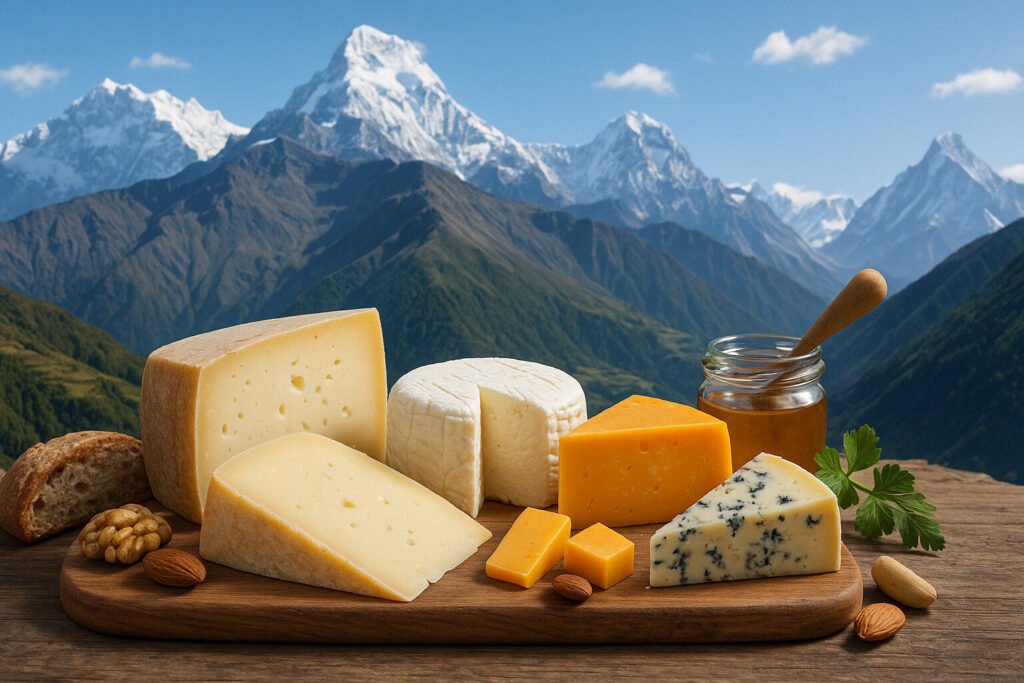Cheese Of The Himalayas
Definition and Scope
Himalayan cheese refers to dairy products originating from the high-altitude regions of the Himalayas, including Nepal, Bhutan, and northern India. These cheeses are traditionally made from the milk of yaks, churpus, or dzomos, which are animals adapted to the mountainous terrain. The category encompasses both fresh and aged varieties, often shaped by the challenging climate and limited resources of the area.
Production methods are typically artisanal, relying on indigenous knowledge passed down through generations. The scope includes unique regional specialties such as Chhurpi, a hardened cheese often used as a chewing snack. These cheeses are integral to the local diet and economy, reflecting the cultural heritage of Himalayan communities.
Production Techniques
Traditional Himalayan cheese production begins with raw milk, which is heated and coagulated using natural acids or plant-based rennet. For Chhurpi, the curds are pressed and dried repeatedly to achieve a rock-hard texture suitable for prolonged chewing. This process preserves the cheese without refrigeration, which is essential in remote high-altitude locations.
Modern adaptations sometimes incorporate pasteurization and commercial cultures to meet food safety standards. Aging, when applied, occurs in cool, dry caves or storage rooms, leveraging the natural environment. The techniques emphasize sustainability, utilizing local materials and minimizing waste in resource-scarce settings.
Sensory Profile
Himalayan cheeses exhibit a range of flavors from mild and milky in fresh versions to intensely savory and tangy in aged products. Chhurpi, for example, offers a firm, almost woody texture that releases subtle dairy notes upon chewing. The use of yak milk imparts a richer, slightly gamey flavor compared to cow’s milk varieties.
Aroma profiles can include earthy, fermented notes due to the natural microflora present in the raw milk and aging environments. The color varies from pale white to deep yellow, depending on the animal’s diet and the cheese’s age. These sensory characteristics are distinct from Western cheeses, offering a unique tasting experience.
Culinary Uses
In local cuisine, Himalayan cheeses are consumed as snacks, incorporated into stews, or grated over traditional dishes like thukpa or momos. Hard cheeses like Chhurpi are often carried by travelers and herders as a durable, protein-rich food source. They provide essential nutrients in regions where fresh produce is scarce.
Contemporary chefs use these cheeses to add authentic Himalayan flavors to fusion dishes, such as salads or pasta. The hard varieties can be shaved or grated as a seasoning, similar to Parmesan. Their versatility extends to melting in hot soups, where they contribute depth and umami.
Regional Examples
Nepal produces Chhurpi in both hard and soft forms, with the hard type being a national staple. Bhutan offers similar cheeses, often made from yak milk and consumed during festive occasions. These products are central to the pastoral livelihoods in these countries.
In India’s Himalayan states like Sikkim and Ladakh, local dairies craft cheeses using cow or hybrid animal milk. Artisanal producers are gaining recognition for preserving traditional methods while exploring new styles. Each region’s cheese reflects its specific cultural practices and environmental conditions.

